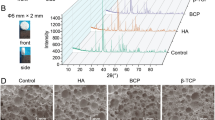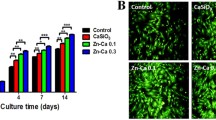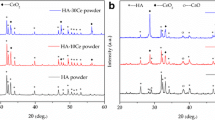Abstract
Hydroxyapatite (HA) is a widely used calcium phosphate implant substitute and has dissolution property. Although HA has been shown a beneficial effect on osteoblast differentiation, the exact mechanism is still unclear. In the present study, we proposed that Ca2+ released from HA activated the expression bone associated proteins, OPN and BSP, mediated by L-type calcium channel and calcium/calmodulin-dependent protein kinase (CaMK) 2 which resulted into improved osteoblast differentiation. Results showed that HA elevated ALP expression as well as OPN and BSP expression in MC3T3-E1 cells. The result from western blot of CaMK2α indicated that HA released Ca2+ activated CaMK2 through L-type calcium channel. Furthermore, upregulation of OPN and BSP mRNA expression was significantly inhibited when blocking both the L-type calcium channel and CaMK2. These findings suggested that HA accelerated the osteoblast differentiation by releasing Ca2+.





Similar content being viewed by others
References
Jarcho M. Retrospective analysis of hydroxyapatite development for oral implant applications. Dent Clin N Am. 1992;36:19–26.
Shu R, McMullen R, Baumann MJ, McCabe LR. Hydroxyapatite accelerates differentiation and suppresses growth of MC3T3-E1 osteoblasts. J Biomed Mater Res. 2003;67:1196–204.
Ohgushi H, Dohi Y, Tamai S, Tabata S. Osteogenic differentiation of marrow stromal stem cells in porous hydroxyapatite ceramics. J Biomed Mater Res. 1993;27:1401–7.
Okumura M, Ohgushi H, Dohi Y, Katuda T, Tamai S, Koerten HK, et al. Osteoblastic phenotype expression on the surface of hydroxyapatite ceramics. J Biomed Mater Res. 1997;37:122–9.
Ma S, Yang Y, Carnes DL, Kim K, Park S, Oh SH, et al. Effects of dissolved calcium and phosphorous on osteoblast responses. J Oral Implantol. 2005;31(2):61–7.
Nayab SN, Jones FH, Olsen I. Effects of calcium ion-implantation of titanium on bone cell function in vitro. J Biomed Mater Res. 2007;83:296–302.
Maeno S, Niki Y, Matsumoto H, Morioka H, Yatabe T, Funayama A, et al. The effect of calcium ion concentration on osteoblast viability, proliferation and differentiation in monolayer and 3D culture. Biomaterials. 2005;26(23):4847–55.
Zayzafoon M. Calcium/calmodulin signaling controls osteoblast growth and differentiation. J Cell Biochem. 2006;97:56–70.
Yamaguchi T, Chattopadhyay N, Kifor O, Butters RR Jr, Sugimoto T, Brown EM. Mouse osteoblastic cell line (MC3T3-E1) expresses extracellular calcium (Ca2+o)-sensing receptor and its agonists stimulate chemotaxis and proliferation of MC3T3-E1 cells. J Bone Miner Res. 1998;13(10):1530–8.
Zayzafoon M, Fulzele K, McDonald JM. Calmodulin and Calmodulin-dependent kinase 2a regulate osteoblast differentiation by controlling c-fos expression. J Biol Chem. 2005;280:7049–59.
Gordon JA, Tye CE, Sampaio AV, Underhill TM, Hunter GK, Goldberg HA. Bone sialoprotein expression enhances osteoblast differentiation and matrix mineralization in vitro. Bone. 2007;41(3):462–73.
Boskey AL. Noncollagenous matrix proteins and their role in mineralization. Bone Miner. 1988;6:111–23.
Denhardt DT, Guo X. Osteopontin: a protein with diverse functions. FASEB J. 1993;7:1475–82.
Zayzafoon M. Calcium/calmodulin signaling controls osteoblast growth and differentiation. J Cell Biochem. 2006;97(1):56–70.
Müller P, Bulnheim U, Diener A, Lüthen F, Teller M, Klinkenberg ED, et al. Calcium phosphate surfaces promote osteogenic differentiation of mesenchymal stem cells. J Cell Mol Med. 2008;12(1):281–91.
Barry EL. Expression of mRNAs for the alpha 1 subunit of voltage-gated calcium channels in human osteoblast-like cell lines and in normal human osteoblasts. Calcif Tissue Int. 2000;66(2):145–50.
Yamaguchi T. The calcium-sensing receptor in bone. J Bone Miner Metab. 2008;26(4):301–11.
Chattopadhyay N, Yano S, Tfelt-Hansen J, Rooney P, Kanuparthi D, Bandyopadhyay S, et al. Mitogenic action of calcium-sensing receptor on rat calvarial osteoblasts. Endocrinology. 2004;145(7):3451–62.
Pedersen ME, Fortunati D, Nielsen M, Brorson SH, Lekva T, Nissen-Meyer LS, et al. Calmodulin-dependent kinase 1beta is expressed in the epiphyseal growth plate and regulates proliferation of mouse calvarial osteoblasts in vitro. Bone. 2008;43(4):700–7.
Siebers MC, ter Brugge PJ, Walboomers XF, Jansen JA. Integrins as linker proteins between osteoblasts and bone replacing materials. A critical review. Biomaterials. 2005;26(2):137–46.
Puleo DA, Nanci A. Understanding and controlling the bone-implant interface. Biomaterials. 1999;20(23–24):2311–21.
Bernards MT, Qin C, Ratner BD, Jiang S. Adhesion of MC3T3-E1 cells to bone sialoprotein and bone osteopontin specifically bound to collagen I. J Biomed Mater Res A. 2008;86(3):779–87.
Sakata R, Minami S, Sowa Y, Yoshida M, Tamaki T. Trichostatin A activates the osteopontin gene promoter through AP1 site. Biochem Biophys Res Commun. 2004;315(4):959–63.
Takai H, Araki S, Mezawa M, Kim DS, Li X, Yang L, et al. AP1 binding site is another target of FGF2 regulation of bone sialoprotein gene transcription. Gene. 2008;410(1):97–104.
Acknowledgments
This study was supported by the grant of Korea Science and Engineering Foundation (KOSEF) grant funded by the Korea government (MOST) No. R01-2007-000-10977-0 and Ministry of Science and Technology (Regenomics, M10528010004-06N2801-00410).
Author information
Authors and Affiliations
Corresponding author
Rights and permissions
About this article
Cite this article
Jung, GY., Park, YJ. & Han, JS. Effects of HA released calcium ion on osteoblast differentiation. J Mater Sci: Mater Med 21, 1649–1654 (2010). https://doi.org/10.1007/s10856-010-4011-y
Received:
Accepted:
Published:
Issue Date:
DOI: https://doi.org/10.1007/s10856-010-4011-y




